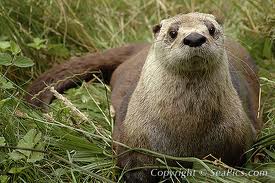River Otter
Category: North American Mammals

Facts about North American River Otter, "Scientific name for River Otter is Lontra Canadensis". River Otters live in Canada, Alaska, and continental United States. In other areas, it is referred to as the Northern River Otters or the common Otter. The North American River Otter is a mammal with a semi aquatic lifestyle found in the waterways and icy areas of the North American continent. When it is fully grown, a River Otter can weigh up to 18-24 lbs (8 to 11 kg) females weigh a little less 15-22 (6.8 to 10 kg) the Length of the North American River Otter is 26-42 inches (66 to 106cm). A major part of its total length is taken up by its long and tapered tail which averages 12-18 inches (30 to 45cm). The River Otter is known all over the world for its water repellent coat of thick fur.
It belongs to the weasel family and it has an impressive adaptability on land and the in water. North American River Otter digs holes and burrows in areas close to rivers, lakes, or swamp edges. Inside, the burrow it has multiple tunnel openings which allow the River Otter to get in and get out of the water and back in at its convenience. The females usually gives birth in these tunnels.
Physical Description of River Otter
The North American River Otter has a streamlined shape that enables it to glide through Ice, water and icy water. The nose and ears will close automatically when diving and the North American River Otter can stay submerged for up eight minutes. River Otter uses anal scent glands to mark its territories, which is known to cover up to 50 miles. River Otters have a long, streamlined body with short legs, a broad head, and webbed toes. The face has a bulbous nose (Resembling a bulb in shape; swollen and rounded), and vibrissae (whiskers near mouth) and small eyes. The small nostrils and ears can be closed when the River Otter is in water. North American River Otters have dark brown sleek fur that is dense and short, with a heavy soft, oily underfur and smooth guard hairs that are glossy. The fur underneath the River Otter is lighter brown than that on its top hair. It has short legs and a smaller head and a muscular neck that complement its elongated body which is broad at the hip area. Compared to the European Otter, the North American River Otter has a longer neck and a smaller space between its ears.
There is distinct sexual dimorphism with the male River Otters averaging 5 percent more in body size compared to their female counterparts.
Behavioral Pattern of North American River Otter
River Otters are among the most active semi aquatic mammals. Throughout the year, the river otters are active mostly at night. During spring, summer and part of the fall season, they come out to hunt and play around at night while in winter months the River Otter can be spotted during the day, because of seasonal food shortages and harsh environmental conditions it is common to see the river otters migrating from one area to another, they do not however do this on an annual basis but rather periodically.
Reproduction of River Otter
The North American River Otters are known to be polygamous. The females start the reproduction process when they reach at least two years of age. The males are also sexually active around the same time bringing in a balance in the community. The breeding season for the North American River Otters is between December and April with copulation lasting for about 20 to 75 minutes. When it comes to breeding, the River Otter can either do it in the water or on terrestrial land. The gestation period lasts between 60 to 65 days. The young North American River Otters are usually born between the month of February and April. Pups will open there eyes in about 35 days
The mother River Otter is the one responsible for raising the young ones. The pups grow their coats when they are about two months old, the exact time their mother introduces them to aquatic life.

 Back To Category North American Mammals
Back To Category North American Mammals